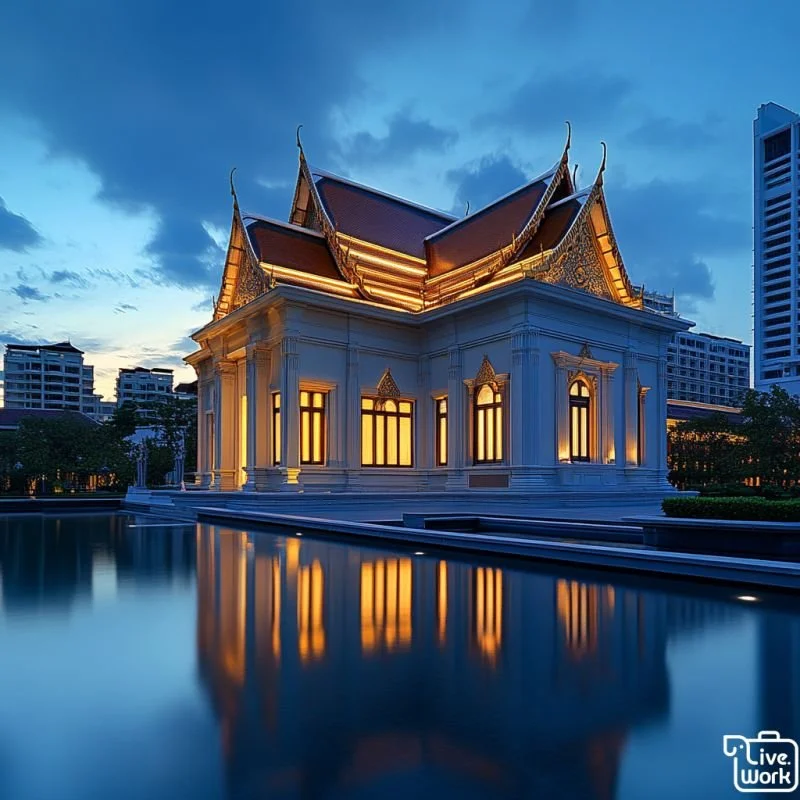Thai Art and Architecture: A Living Legacy of Spirituality and Craftsmanship
Walk through the streets of Bangkok or the courtyards of Chiang Mai, and you’ll be surrounded by a visual language that speaks of both eternity and evolution. From gilded temple roofs that shimmer under the sun to intricate woodcarvings that tell stories of gods and legends, Thai art and architecture embody a rich cultural tapestry woven over centuries.
With its roots in religion, mythology, and regional traditions, Thai design is as symbolic as it is aesthetic—a harmony of form, function, and spiritual meaning. Today, as modern architecture rises across urban skylines, these traditions continue to evolve, influencing everything from contemporary buildings to global design trends.
🛕 The Soul of Thai Architecture: Temples, Stupas, and Spirit
Thai architecture has long been intertwined with Buddhism, which informs the layout, form, and ornamentation of many iconic structures.
Temples (Wat)
The cornerstone of Thai architectural identity is the Buddhist temple, or wat. Each complex typically includes:
Ubosot (ordination hall): The holiest space where monks perform rituals.
Viharn (assembly hall): Used for ceremonies and worship.
Chedi or Stupa: Bell-shaped structures containing relics or ashes.
Ho Trai (library) and Belfry: Housing sacred scriptures and ceremonial bells.
Temples are designed not just for function but to reflect cosmic harmony—mirroring Mount Meru, the center of the Buddhist universe.
Distinctive Features:
Tiered roofs with upward-curving finials (chofa) symbolizing mythical Garuda birds or nagas.
Gilded surfaces and colored glass mosaics, representing enlightenment and purity.
Symmetry and axial layouts, rooted in ancient cosmological beliefs.
Famous Examples:
Wat Arun (Bangkok): Towering prangs covered in porcelain tiles.
Wat Phra That Doi Suthep (Chiang Mai): A mountain-top temple radiating spiritual grandeur.
Wat Rong Khun (The White Temple): A contemporary reinterpretation by artist Chalermchai Kositpipat, blending pop culture and Buddhist motifs.
🎨 Thai Art: A Visual Story of Belief and Beauty
Murals and Mosaics
Thai temples are treasure troves of mural paintings, often depicting scenes from:
The Jataka tales (previous lives of the Buddha).
The Ramakien, Thailand’s version of the Ramayana.
Daily life, mythical creatures, and moral teachings.
Artists use natural pigments and mineral-based colors, often layering figures in visual hierarchies that indicate status and divinity.
Woodcarving
A hallmark of northern Thai art, particularly in Chiang Mai and Nan, Thai woodcarving is known for:
Detailed floral and animal motifs.
Lintel carvings, door panels, and spirit houses.
Symbolic guardians like nagas (serpents), kinnaree (bird-women), and lions.
Wood is both material and metaphor—connecting craftsmanship with nature and spirituality.
Sculpture
Thai sculptures are deeply spiritual, depicting:
Buddhas in various poses, each signifying different virtues (e.g., calling the Earth to witness, meditating, teaching).
Yaksha (giant guardians) at temple gates.
Mythological hybrids, like the naga, garuda, and hanuman, reflecting Hindu-Buddhist fusion.
Sculptures are often gilded, lacquered, or inlaid with semiprecious stones, showcasing technical mastery and devotion.
🏙 Blending Tradition and Modernity in Thai Design
Contemporary Thai architecture does not reject tradition—it integrates it, creating a dialogue between the old and the new.
Modern Thai Buildings Inspired by Tradition:
Cultural centers and universities incorporating sloped roofs and local materials.
Hotels and resorts using Thai-style pavilions (sala) for luxury appeal.
Urban homes designed with stilted floors and open-air courtyards for ventilation and aesthetics.
Modern Thai designers often apply traditional principles like balance, asymmetry, harmony with nature, and the symbolic use of space (e.g., north-facing Buddha rooms, feng shui adaptations).
Notable modern architects, such as Duangrit Bunnag, bring Thai sensibilities to contemporary forms using local wood, brick, and concrete, and prioritize natural light and flow—aesthetic minimalism with cultural depth.
🌏 Thai Artistic Influence Beyond Borders
Thai silk patterns, decorative motifs, and architectural flourishes inspire designers in fashion, interior design, and global architecture.
Fusion temples like Wat Rong Khun incorporate Western pop imagery, showing the adaptability of Thai visual language.
Thai design aesthetics appear in international exhibitions, heritage preservation programs, and digital media.
Final Thoughts: A Living Tradition of Elegance and Meaning
From sacred stupas and celestial murals to minimalist homes with ancient echoes, Thai art and architecture reflect the soul of a nation rooted in history yet open to evolution. These forms aren’t frozen in the past—they’re constantly reimagined, just as relevant in serene temples as they are in modern Bangkok lofts or eco-resorts.
